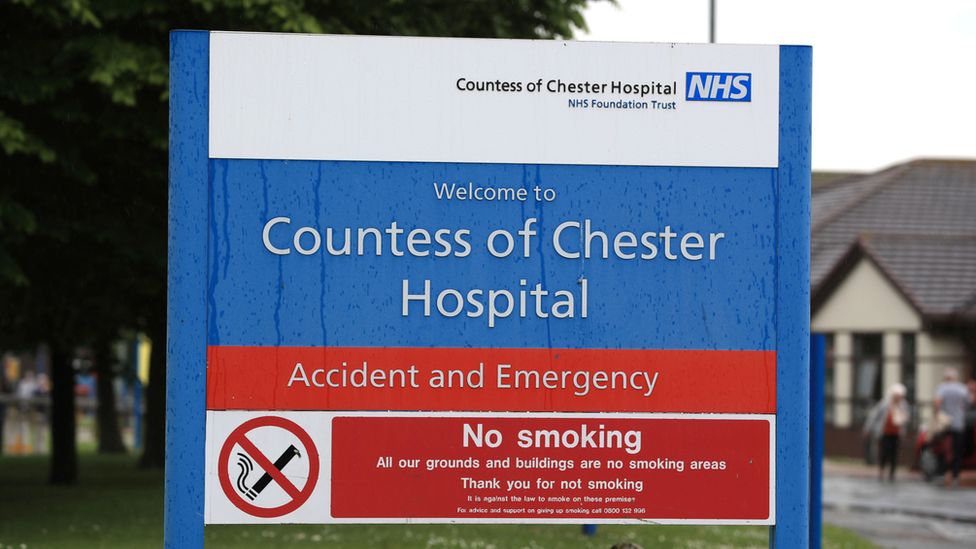Lucy Letby: Baby suffered devastating internal injury, court hears
- Published

Lucy Letby denies murdering and attempting to murder babies on a neo-natal ward
A premature baby boy suffered a "devastating" internal injury that contributed to his death, the murder trial of nurse Lucy Letby has heard.
Ms Letby is said to have killed the boy, referred to as Child O, in June 2016 on her return from a week's holiday in Ibiza.
The nurse is charged with murdering seven babies and attempting to murder 10 others at the Countess of Chester Hospital between 2015 and 2016.
The 33-year-old denies all charges.
Manchester Crown Court has previously heard that Child O was in good condition and stable up until the afternoon of 23 June when he suffered a "remarkable deterioration" and died.
The boy was one of triplets and his brother, referred to as Child P, died just over 24 hours later after also being allegedly attacked by Ms Letby.
Dr Andreas Marnerides, an expert in neonatal pathology, told the court in his view Child O's death was a result of an "inflicted traumatic injury to the liver" and the injection of air into the boy's bloodstream via a nasogastric tube.
To assist the jury with his findings in relation to Child O, Dr Marnerides presented photographs of the baby boy's liver, taken at the post-mortem examination, to the court.
The images revealed a "rather large bruise" on the boy's liver that would have caused an internal bleed, Dr Marnerides said.
He said the "most likely" cause of the bruising would be "an impact type of injury".
"It doesn't tell us if it is accidental or not accidental, but tells us it is impact," he added.
The medic ruled out CPR as a possible cause of the bruise, saying: "I cannot convince myself that in the setting of a neonatal care unit, CPR would be a reasonable proposition to explain this.
"I don't think CPR can produce this extensive injury to a liver."

The nurse is accused of carrying out the attacks at Countess of Chester Hospital
He said the severity of the injury was more consistent with that suffered in a road-traffic accident, adding: "I have also seen it in babies in the context of cases where they have suffered non-accidental types of injury."
Asked whether medics would have seen Child O in distress as a result of the injury, he said: "It's very common that you see nothing from the outside, especially in a baby.
"You can have the most devastating injury internally and yet nothing is visible from the outside."
Dr Marnerides, who was approached to review the case by Cheshire Police in 2017, went on to say that it was "likely" a number of babies died at the Countess of Chester Hospital as a result of air being injected into their bloodstreams.
The medic said upon reviewing tissue samples from Child A, who the Crown alleged was murdered by Ms Letby in June 2015 via air injection, he found "globules" in the lungs and brain tissue that were most likely air.
He said: "I cannot be 100% sure, but most likely this air went there while this baby was still alive."
Dr Marnerides said in his opinion there was "no evidence that a natural disease would explain his death" and concluded that death was "explicable on the basis of air embolism".
Dr Marnerides offered a similar explanation for the deaths of Child C in June 2015.
The Crown said Ms Letby, who is originally from Hereford, murdered the five-day-old boy by injecting air into his stomach through a nose tube, making him unable to breathe.
Dr Marnerides said there was "no evidence" of infection in the pathology and ruled out other conditions as a cause of death.
"I think the explanation for sudden collapse was excess injection of air into the nasogastric tube," he said.
Likewise with the deaths of Child D and Child I in 2015, he said the "likely explanation" was the injection of air.
The trial continues.

Why not follow BBC North West on Facebook, external, Twitter, external and Instagram, external? You can also send story ideas to northwest.newsonline@bbc.co.uk, external
Related topics
- Published23 March 2023

- Published22 March 2023

- Published21 March 2023

- Published20 March 2023

- Published16 March 2023

- Published15 March 2023

- Published14 March 2023

- Published8 March 2023
